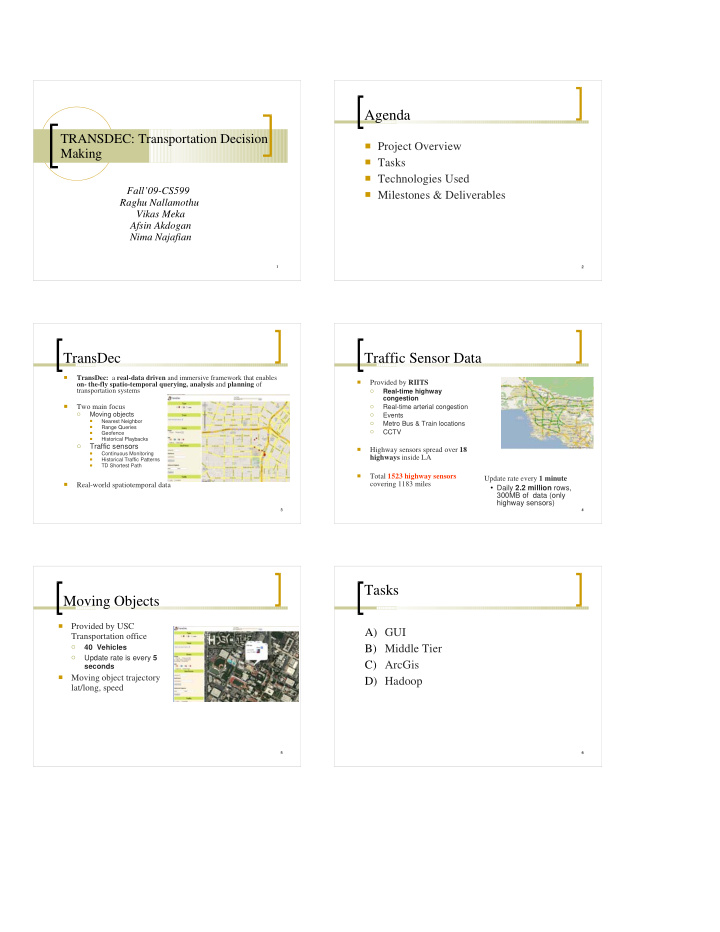



Agenda TRANSDEC: Transportation Decision � Project Overview Making � Tasks � Technologies Used Fall’09-CS599 � Milestones & Deliverables Raghu Nallamothu Vikas Meka Afsin Akdogan Nima Najafian 1 1 2 2 TransDec Traffic Sensor Data � TransDec: a real-data driven and immersive framework that enables � Provided by RIITS on- the-fly spatio-temporal querying, analysis and planning of transportation systems � Real-time highway congestion � Two main focus � Real-time arterial congestion Moving objects � � Events � Nearest Neighbor � Metro Bus & Train locations � Range Queries CCTV � � Geofence � Historical Playbacks Traffic sensors � � Highway sensors spread over 18 � Continuous Monitoring highways inside LA � Historical Traffic Patterns � TD Shortest Path � Total 1523 highway sensors Update rate every 1 minute covering 1183 miles � Real-world spatiotemporal data � Daily 2.2 million rows, 300MB of data (only highway sensors) 3 4 3 4 Tasks Moving Objects � Provided by USC A) GUI Transportation office � 40 Vehicles B) Middle Tier � Update rate is every 5 C) ArcGis seconds � Moving object trajectory D) Hadoop lat/long, speed 5 5 6 6
Tasks A & B GUI & Middle Tier 1.Real-time data integration from RIITS Traffic Sensor Data for main Streets � CCTV � 2.Generic Query Interface , “Middle Tier” 3.Temporal Traffic Pattern Analysis 4.Traffic Flow Implementation 5.CCTV Footages 6.Granular Querying 7 7 8 8 Task A -RIITS Data Integration Task B -Query Interface � A generic Query interface is designed to interact with all the webservices. � Data is Provided in an predefined XML format. � Based on the type of request each of them is � Traffic sensor data and the CCTV snapshots are called for a specific purpose. updated every minute � All the webservices can be accessed through � Congestion freeway inventory data is updated on SOAP calls. a daily basis � CCTV Inventory data is updated quarterly. 9 10 9 10 Task A -Traffic Flow Temporal Traffic Pattern Analysis Implementation Users can � Monitoring the movement of adjust the date traffic in any and time to specific location analyse traffic between various patterns segments. 11 11 12 12
Task A - CCTV Footages Task B - Granular Querying � Users can also view � We can Custom Query any segment of CCTV footages of the map to retreive historical patterns vehicular flow at about the vehicular flow. various segements. � If we have multiple snapshots of a particular location we also show them a video. 13 13 14 14 Cube Operations ArcGis 15 16 16 15 Task C - Getting Started ArcGIS Integration What Are we trying to do: Preparing the programming environment: obtaining the software and installing it � Feed ArcGIS with our Data � Use ArcGIS tools and functions to display our data � Import our queries to ArcGIS and adjusting them to work with ArcGIS libraries and tools(Current Traffic and Traffic prediction) 17 18
Task C – Connecting Oracle to ArcGis Task C - Querying Traffic Connecting to OracleDB using a direct Connection Displaying realtime traffic flow on the map Utilize ARCTOOLBOX for geoprocessing Visualizing current traffic and the historical pattern (extract,overlay,..) using ArcGIS Analysis tools Query our data(highway sensors) with ArcMap and mapping it by adding data layers ( displaying highway sensors) 19 20 Task C - Tracking moving objects Tracking moving objects using Arc GIS Tracking Hadoop Analyst 22 22 21 Task D–Distributed Computing Task D - Hadoop What is Hadoop? � GeoSpatial Queries � A Software Framework to support data � intensive distributed applications. It enables Computationally Complex � to work with thousands of nodes and Time Consuming on large Datasets � petabytes of data. Solution � � Why do we need Hadoop ? Parallelize the Queries Parallelization � � Scalability � Fault Tolerance � Cost Effectiveness � 23 23 24 24
Task D – Execution Flow Task D - Map/Reduce Hadoop File System Map/Reduce Model Retreiving Hadoop output Automating input to Hadoop 25 25 26 26 Week/Tasks 1 2 3 4 5 6 7 8 9 10 11 12 RIITS Vikas ` CCTV FOOTAGE Vikas Technologies Used TRAFFIC FLOW Vikas MIDDLE TIER Raghu PATTERN Raghu ANALYSIS � Oracle Spatial – PL/SQL GRANULAR Raghu QUERYING SOFTWARE � AJAX, Flex Nima ENVIRONMENT ARCGIS Nima � Java- Servlet, Jsp QUERYING Nima TRAFFIC � SOAP, XML, WSDL TRACKING MOVING Nima OBJECTS HADOOP File System Afsin MAP MODEL Afsin HADOOP OUTPUT Afsin ANALYSIS 27 27 28 AUTOMATING Afsin HADOOP I/P Deliverables- Vikas Deliverables- Raghu Understanding and displaying the data Middle Tier implementation – 4 weeks from RIITS – 4 weeks Traffic pattern analysis – 4 weeks Including the CCTV footages in the GUI Granular Querying and retreiving – 4 weeks results – 4 weeks Implementing traffic flow – 4 weeks 29 30
Deliverables- Nima Deliverables- Afsin Installing ArcGIS – 3 weeks Retreiving output from Hadoop -9 Loading our data to ArcGIS – 3 weeks weeks Automating input to Hadoop – 3 weeks Querying Traffic - 3 weeks Tracking moving objects – 3 weeks 31 32 Thank You 33
Recommend
More recommend